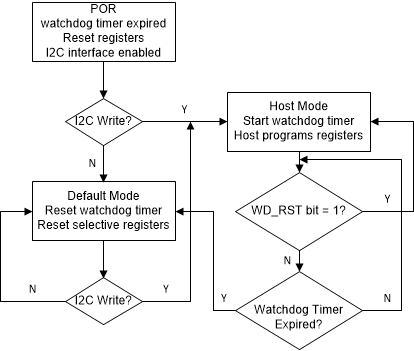SLUSDF8E June 2019 – July 2024 BQ25618 , BQ25619
PRODUCTION DATA
- 1
- 1 Features
- 2 Applications
- 3 Description
- 4 Description (continued)
- 5 Pin Configuration and Functions
- 6 Specifications
-
7 Detailed Description
- 7.1 Overview
- 7.2 Functional Block Diagram
- 7.3
Feature Description
- 7.3.1 Power-On-Reset (POR)
- 7.3.2 Device Power Up From Battery Without Input Source
- 7.3.3 Power Up From Input Source
- 7.3.4 Boost Mode Operation From Battery
- 7.3.5 Power Path Management
- 7.3.6 Battery Charging Management
- 7.3.7 Ship Mode and QON Pin
- 7.3.8 Status Outputs (STAT, INT , PMID_GOOD)
- 7.3.9 Protections
- 7.3.10 Serial Interface
- 7.4 Device Functional Modes
- 7.5 Register Maps
- 8 Application and Implementation
- 9 Power Supply Recommendations
- 10Layout
- 11Device and Documentation Support
- 12Revision History
- 13Mechanical, Packaging, and Orderable Information
Package Options
Mechanical Data (Package|Pins)
- YFF|30
Thermal pad, mechanical data (Package|Pins)
Orderable Information
7.4.1 Host Mode and Default Mode
The device is a host controlled charger, but it can operate in default mode without host management. In default mode, the device can be used as an autonomous charger with no host or while the host is in sleep mode. When the charger is in default mode, the WATCHDOG_FAULT bit is HIGH. When the charger is in host mode, the WATCHDOG_FAULT bit is LOW.
After power-on-reset, the device starts in default mode with watchdog timer expired, or default mode. All registers are in the default settings.
In default mode, the device keeps charging the battery with the 10-hour fast charging safety timer. At the end of the 10-hour, charging is stopped and the buck converter continues to operate to supply system load. Any write command to the device transitions the charger from default mode to host mode. All device parameters can be programmed by the host. To keep the device in host mode, the host has to reset the watchdog timer by writing a 1 to the WD_RST bit before the watchdog timer expires (WATCHDOG_FAULT bit is set), or disable the watchdog timer by setting the WATCHDOG bits = 00.
All device parameters can be programmed by the host. To keep the device in host mode, the host has to reset the watchdog timer by writing a 1 to the WD_RST bit before the watchdog timer expires (WATCHDOG_FAULT bit is set), or disable the watchdog timer by setting the WATCHDOG bits = 00.
 Figure 7-15 Watchdog Timer Flow Chart
Figure 7-15 Watchdog Timer Flow Chart